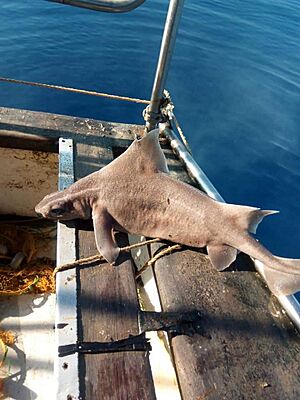Angular roughshark facts for kids
The angular roughshark (Oxynotus centrina) is a unique type of rough shark. It belongs to the family called Oxynotidae. These sharks have a very distinct look, almost like a triangle!
Quick facts for kids Angular roughshark |
|
|---|---|
 |
|
| Conservation status | |
| Scientific classification | |
| Genus: |
Oxynotus
|
| Species: |
centrina
|
 |
|
| Range of the angular roughshark (in blue) | |
Contents
Discovering the Angular Roughshark
A famous biologist named Carl Linnaeus first described the angular roughshark in 1758. He gave it the scientific name O. centrina. This name was officially accepted by scientists in 1976.
What Does It Look Like?
Angular roughsharks are born quite small, less than 25 cm (9.8 in) long. They grow up to about 50 cm (20 in) when they become adults. Most angular roughsharks found are less than 1 m (3.3 ft) long. However, some can reach up to 1.5 m (4.9 ft).
Their body is flattened from side to side, making it look like a triangle when you cut across it. They have a wide, flat head with a blunt snout. Like all sharks in the Oxynotus group, they have two large, sail-like fins on their back. They do not have an anal fin.
These sharks are usually grey or grey-brown on top. They often have dark spots on their head and sides. A special feature is a light line that runs horizontally below their eyes on their cheek.
They have special bumps above their eyes that turn into large, round knobs. These knobs are covered with big denticles, which are like tiny, tooth-like scales. Other rough shark species don't have these. They also have very large spiracles, which are breathing holes behind their eyes. These spiracles are almost as tall as their eyes are long.
Their first dorsal fin (the one closer to the head) points slightly forward. They have sharp, blade-like teeth in their lower jaw. Their upper teeth are shaped like spearheads. They have 12 rows of teeth on each side of their mouth.
What Do They Eat?
Angular roughsharks are bottom feeders. They like to eat worms, crustaceans (like crabs and shrimp), and mollusks (like snails and clams).
Where Do They Live?
These sharks live in the eastern Atlantic Ocean. You can find them from Norway all the way down to South Africa. They also live throughout the entire Mediterranean Sea. They might even be found off the coast of Mozambique.
They prefer to live on the seafloor where it's muddy or covered with special algae. They are usually found on continental shelves and upper slopes. This is typically at depths from 50 to 660 m (160 to 2,170 ft). Most of the time, they are found deeper than 100 m (330 ft).
Studies in the Mediterranean Sea show they like to spend their time between 60 to 600 m (200 to 1,970 ft) deep. They often glide along the bottom of the sea. Sometimes, they even hover over sandy or muddy areas.
How Do They Have Babies?
Male and female angular roughsharks become adults when they are about 50–70 cm long. Females usually mature at a slightly larger size than males.
Angular roughsharks are ovoviviparous. This means the mother carries the eggs inside her body until they hatch. The pups then develop inside her until they are ready to be born. They usually have 10 to 12 pups at a time. Each baby shark is about 21 to 24 cm long when it's born.
How Many Are There?
Scientists have collected information on angular roughsharks in the Mediterranean Sea. From 1994 to 1999, they were found in only a small percentage of fishing nets. They were mostly seen at depths of 100 to 200 meters.
They seem to be more common in the central western Mediterranean. They are less common in the western and eastern parts. They were completely missing from the east-central Mediterranean during these studies.
In 1948, studies showed that angular roughsharks were present, but not common, in the Adriatic Sea. Later studies did not find them there, which made people think they might have disappeared from that area. However, recent studies in 2004 found some young sharks in the central Adriatic. This suggests they are still there!
Also, a single angular roughshark was found at 800 meters deep in the western Ionian Sea. This shows that we still don't know the full size of their population in some areas. However, they used to be common near the Canary Islands until 1997. Now, they are rarely seen there.
Why Are They Endangered?
The angular roughshark is often caught by accident in fishing nets. This is called bycatch. Even though they are not usually targeted by fishermen, this can still harm their population. For example, in the Adriatic Sea, less fishing has helped them reappear after they were thought to be gone.
These sharks have very little commercial value. Fishermen sometimes believe they bring bad luck if caught and kept. When they are released back into the water, they often do not survive.
Because they are often caught by accident and their numbers are decreasing, the IUCN Red List of Threatened Species has listed the angular roughshark as an endangered species. This means they are at high risk of becoming extinct.


